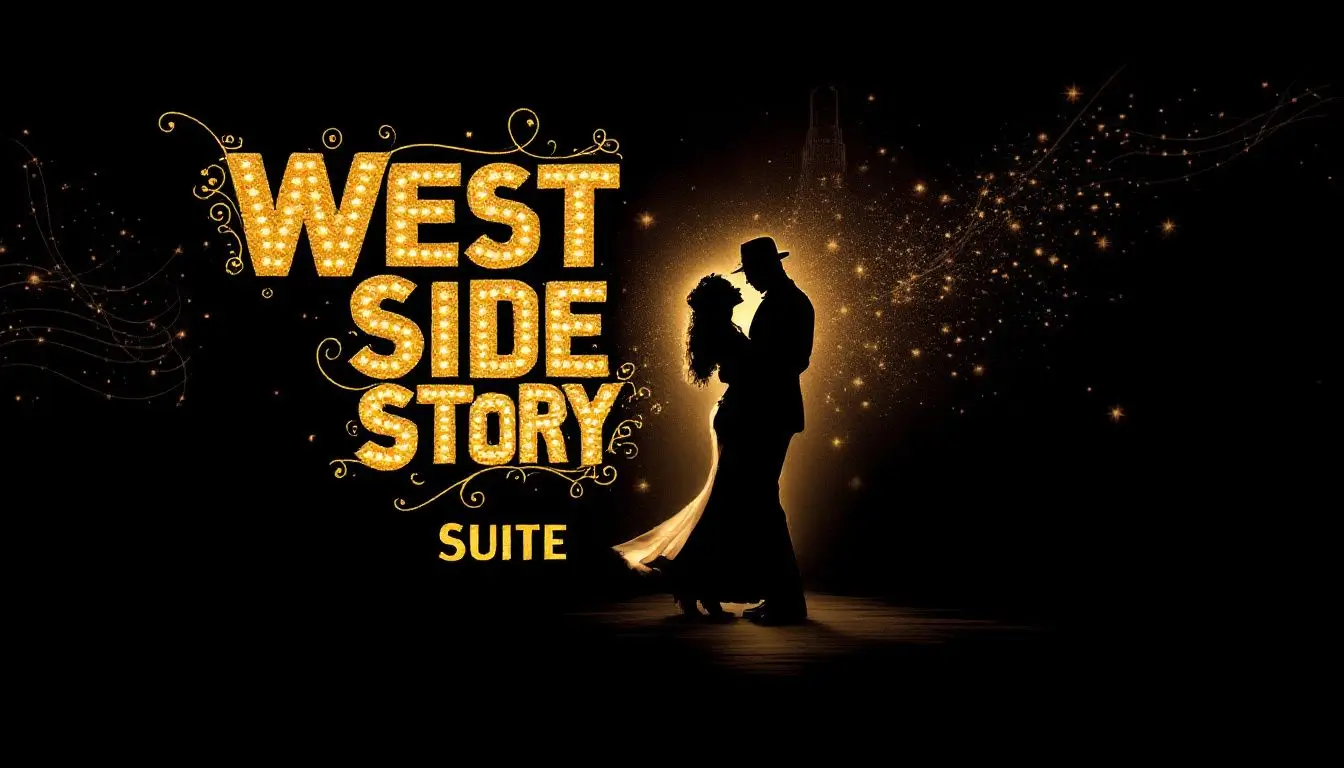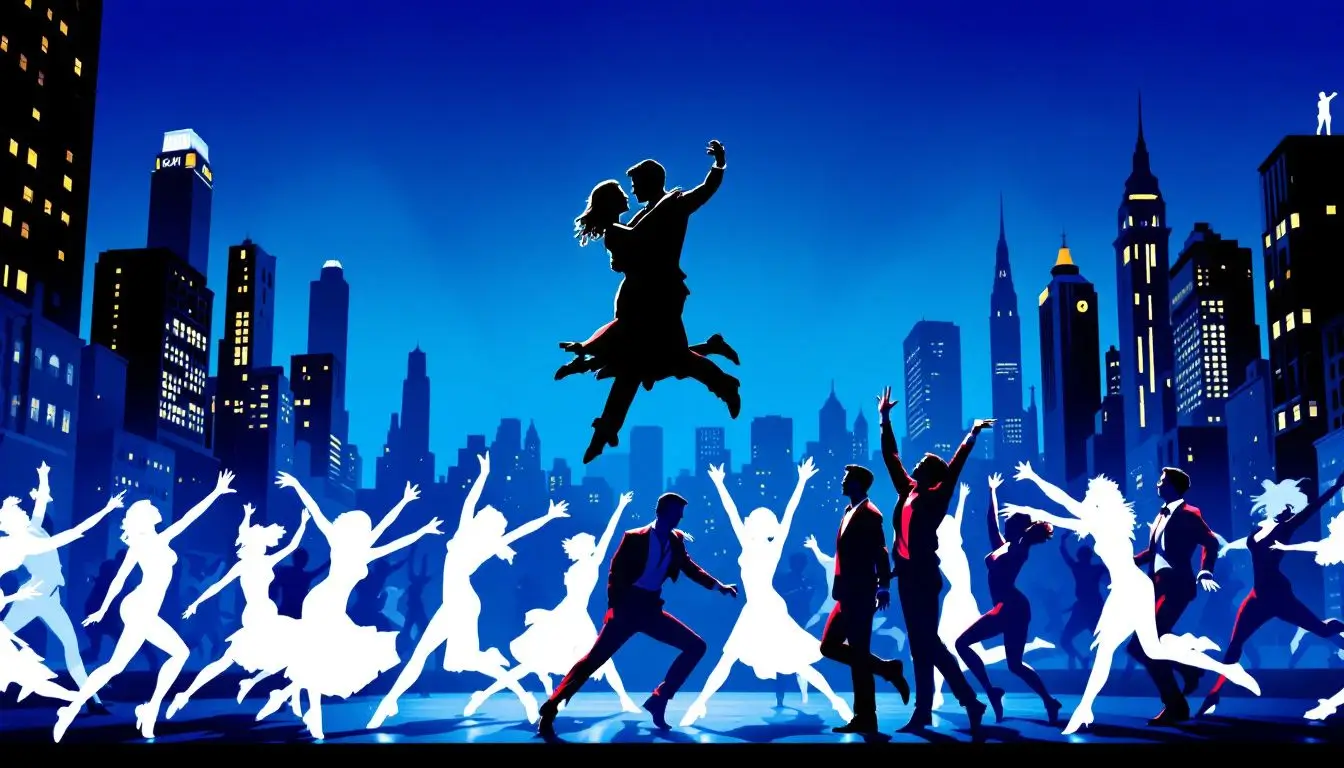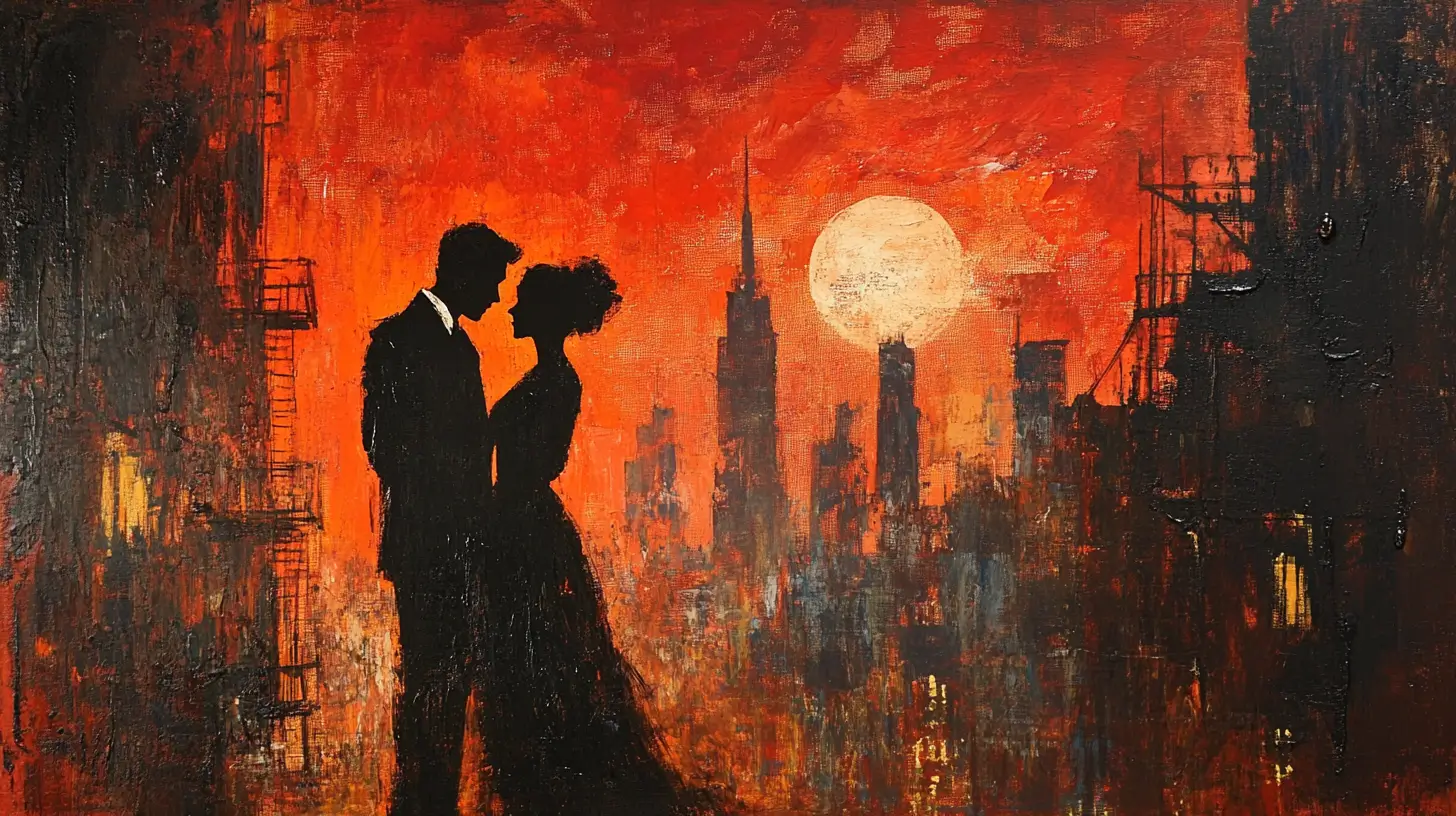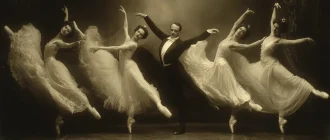The West Side Story Ballet adapts the iconic musical into a ballet. This overview of the West Side Story Suite Ballet explores its creation, key elements, and what makes this adaptation unique.
Graceful Insights
- The West Side Story Suite, evolving from Robbins and Bernstein’s collaboration, integrates diverse musical genres and dance styles, creating a rich narrative experience that resonates across cultures.
- The choreography effectively serves as a storytelling device, merging classical Ballet with Broadway influences, significantly impacting contemporary ballet’s narrative techniques. The original production set a precedent for future adaptations, showcasing the innovative blend of music and dance.
- The rigorous rehearsal process and the conductor’s role are crucial in synchronizing the music and dance, ensuring a cohesive and emotionally impactful performance.
Art de Podcast
| Category | Details |
|---|---|
| Title | West Side Story Suite |
| Choreographer | Jerome Robbins |
| Composer | Leonard Bernstein |
| Lyricist | Stephen Sondheim |
| Premiere | 1995, New York City Ballet |
| Genre | Ballet-Musical Fusion |
| Inspiration | Based on the 1957 Broadway musical West Side Story, which was inspired by Shakespeare’s Romeo and Juliet, |
| Structure | A condensed narrative suite featuring selections from the musical’s songs and dances. |
| Key Musical Numbers | – “Something’s Coming” – “Maria” – “America” – “Somewhere” – “Tonight” |
| Dance Style | A mix of classical ballet, jazz, and Broadway-style movement. |
| Themes | Love, rivalry, cultural tension, and hope for reconciliation. |
| Main Characters | – Tony (Jets) – Maria (Sharks) – Anita – Riff – Bernardo |
| Set Design | Minimalist with a focus on lighting and symbolic props to evoke the atmosphere of New York streets and tensions. |
| Costumes | Iconic color-coded costumes to represent rival gangs (Jets: Cool tones; Sharks: Warm tones). |
| Notable Productions | – New York City Ballet (1995) – San Francisco Ballet – The Royal Ballet |
| Audience Reception | They are celebrated for their innovative combination of ballet and musical theatre storytelling. |
| Legacy | Showcases Robbins’s ability to adapt Broadway success into a ballet repertoire piece. |
The Genesis of West Side Story Suite

The concept for West Side Story originated in the late 1940s, inspired by Jerome Robbins’ ambition to create a modern adaptation of Romeo and Juliet. Set against the backdrop of New York City’s bustling streets, the story of two rival gangs—the Jets and the Sharks — provided a fresh, contemporary take on the classic tale of star-crossed lovers.
The climactic conflict between the two gang leaders, Riff and Bernardo, underscores the themes of violence and tragedy in the story, as their rivalry leads to their deaths and symbolizes the tragic consequences of gang violence.
The Symphonic Dances, which premiered in 1961, extracted sections from the original score to highlight the suite’s emotional depth and narrative. Leonard Bernstein’s innovative musical compositions and Stephen Sondheim’s poignant lyrics create a powerful narrative transcending time.
Bernstein and Robbins’ dynamic partnership, along with the vibrant cultural milieu of New York City’s musical theater, deeply influenced the suite’s inception and development.
Collaboration with Jerome Robbins
Leonard Bernstein and Jerome Robbins’s collaboration on Broadway was revolutionary. Bernstein appreciated Robbins’s exceptional theatrical instincts, which played a crucial role in shaping the musical’s development through theatrical storytelling.
Though complex, their partnership merged Bernstein’s musical innovation with Robbins’s visionary choreography, resulting in a work that was both musically and visually compelling.
Robbins insisted on incorporating gritty realism into West Side Story, treating the dancers as actors to enhance their interpretations of the roles. His choreography drew from various dance styles, including social dances and theatrical techniques, creating a unique dance language that resonated with audiences. This insistence on authenticity and emotional depth transformed how dance was perceived in musical theater.
Influence of New York City
New York City’s vibrant, multicultural urban environment had a significant influence on the themes and character dynamics of West Side Story. The city’s cultural diversity and urban challenges were reflected in the suite’s choreography, dance music, and narrative, which mirrored the tensions and aspirations of the 1950s, making it a powerful cultural artifact.
New York City’s cultural backdrop significantly influenced the themes and choreography of West Side Story. The suite’s portrayal of rivalry and community mirrored the city’s social dynamics, enhancing the story’s emotional and visual impact and making it a timeless piece that resonates with audiences today.
Musical Elements in the Suite

The musical score of the West Side Story Suite masterfully blends classical techniques, jazz rhythms, and Latin motifs. The Symphonic Dances, a central feature of the suite, incorporate these diverse elements to create a dynamic and emotionally charged soundscape. This fusion of styles reflects the suite’s narrative complexity and cultural richness.
The suite’s music seamlessly transitions from lively dance rhythms to poignant love themes, capturing the full spectrum of emotions experienced by the characters. The Symphonic Dances encapsulate the story’s tension and dynamism, providing a rich auditory experience that complements the ballet’s visual storytelling.
Symphonic Dances
The structure of the Symphonic Dances is meticulously crafted to reflect the characters’ emotional arcs in the West Side Story. The arrangement features contrasting sections that narrate the rivalry between the Jets and Sharks, culminating in a dramatic climax. This musical journey mirrors the narrative tension, providing a powerful auditory backdrop to the visual choreography.
Recent productions have highlighted the importance of orchestral arrangements. Musical directors conduct 15-piece orchestras to bring the suite to life with rich, layered sounds. As noted in the program notes, this musical composition integrates classical techniques with dance rhythms and jazz elements, creating a diverse sound palette that enhances the suite’s emotional depth.
Cool Fugue
The West Side Story Suite’s ‘Cool Fugue’ section is a testament to Leonard Bernstein’s musical genius. It features complex counterpoint and rhythmic interplay, showcasing Bernstein’s ability to weave intricate musical dialogues among the instruments. This sophisticated interplay reinforces the narrative tension, making the ‘Cool Fugue’ a significant suite highlight.
Bernstein’s skill in creating intricate musical compositions shines in the ‘Cool Fugue.’ Its complexity and sophistication underscore the suite’s musical diversity, providing a rich auditory experience that complements the visual choreography.
Mambo and Cha Cha
The ‘Mambo’ and ‘Cha Cha’ sections are infused with lively rhythms and Latin motifs, reflecting the cultural influences in the story’s setting. These sections highlight the rhythmic vitality and cultural richness of Latin music, significantly influencing the overall choreography of the West Side Story.
The choreography for these sections, heavily influenced by various dance styles, including jazz and Latin rhythms, underscores the competitive spirit between the gangs and the romantic connection between Tony and Maria. The vibrant dance music enhances the narrative, making these sections memorable highlights.
Choreographic Highlights

The West Side Story Suite’s choreographic highlights showcase how dance sequences are powerful narratives. Jerome Robbins’ choreography effectively blends classical ballet techniques with Broadway styles, creating a unique dance language that resonates with audiences from both genres. This integration of diverse dance styles has significantly influenced contemporary ballet, transforming how stories are told through dance.
The suite’s use of dance as a narrative device has significantly transformed contemporary ballet. By blending expressive movement with technical precision, this unique fusion has set a new standard for storytelling in dance, making the West Side Story Suite a pivotal part of the ballet’s evolution.
Prologue and Meeting Scene
The Prologue of the West Side Story Suite introduces the escalating tension between the two rival gangs, the Jets and the Sharks. Dynamic choreography quickly establishes the conflict, setting a dramatic tone for the ensuing narrative and effectively conveying the rivalry and animosity between the gangs.
The pivotal role of the two gang leaders, Riff and Bernardo, in driving the conflict and setting the dramatic tone for the narrative is particularly highlighted.
The meeting scene, in which Tony and Maria first meet, contrasts sharply with the aggressive energy of the prologue. The choreography of this meeting scene also captures the innocence and hope of their first words and their budding romance, providing a moment of respite amidst the surrounding tension.
Dance of the Two Gangs
The ‘Dance of the Two Gangs’ showcases competitive dance, highlighting the growing rivalry between the Jets and the Sharks. The ‘Cool Fugue’ section features a complex interplay of themes, representing the Jets’ struggle to channel their aggression through competitive dance alone. This intricate sequence of competitive dance moves reflects their internal and external conflicts, adding depth to the narrative.
Dancers in this section face technical challenges, including rapid style changes and seamlessly transitioning between ballet, jazz, and Latin rhythms. These transitions require high levels of skill and precision, making the ‘Dance of the Two Gangs’ a demanding yet exhilarating part of the suite.
In a dream sequence, the two gangs also momentarily find themselves in the same dream —a playful world filled with space, air, and sunlight, which highlights the contrasting emotions presented in the narrative.
Finale and Procession
The West Side Story Suite’s Finale culminates in a poignant emotional resolution, depicting a moment of reconciliation between the gangs. This scene emphasizes unity amidst conflict and growing rivalry, reinforcing the suite’s core messages of love, loss, and the possibility of harmony.
Robbins’s choreography in the Finale demands versatility from dancers, who must convey emotion and physicality seamlessly. This final scene serves as a powerful conclusion to the narrative, leaving a lasting impression on the audience.
Key Performances and Adaptations

Since its premiere, numerous ballet companies have performed the West Side Story Suite worldwide, each bringing its unique interpretation to the classic work. The New York City Ballet has been particularly instrumental in showcasing the suite’s adaptations to the original choreography, highlighting the blend of ballet with authentic gestures and movements influenced by the original musical context.
International ballet companies have also embraced the West Side Story Suite, creating adaptations that reflect local cultural nuances. These performances underscore the suite’s universal appeal, demonstrating its ability to resonate with audiences across different cultures and regions of the playful world.
New York City Ballet
The New York City Ballet first restaged a suite of dances from West Side Story in 1995. This reworked version, choreographed by Jerome Robbins, highlighted the original production’s innovative choreography and musical brilliance. The ballet’s performances have been praised for their dynamic interpretation and faithful execution of Robbins’ vision.
The New York City Ballet’s history with the West Side Story Suite showcases its commitment to preserving and enhancing this iconic work. Their performances continue to captivate audiences, blending ballet’s technical precision with Broadway’s expressive movement, and have even been performed with the New York Philharmonic.
International Adaptations
The West Side Story Suite’s global appeal is evident in its numerous international adaptations. The first Australian production premiered in 1960, a world first reflecting its widespread influence and popularity worldwide. Ballet companies worldwide have adopted the suite, each adding its unique cultural interpretations to the classic work.
These international adaptations highlight universal themes of love, conflict, and reconciliation that resonate with audiences worldwide, all of whom share the same dream. The diverse cultural contexts enrich the suite’s narrative and enhance its global appeal.
Impact of West Side Story Suite on Ballet

The West Side Story Suite has had a profound impact on ballet, significantly influencing modern dance narratives by integrating theatrical elements and music into classical dance. The suite’s themes of love and conflict, inspired by urban environments, resonate deeply with contemporary audiences. Combining diverse musical styles—classical, jazz, and Latin—creates a unique sound that enhances the storytelling in ballet.
Ballet companies worldwide have adapted the West Side Story Suite, reflecting diverse cultural interpretations in their performances. These adaptations demonstrate the suite’s enduring influence and ability to bridge the gap between Broadway and Ballet, transforming how stories are told through dance.
Integration of Broadway and Ballet
The West Side Story Suite is a pivotal bridge between Broadway and Ballet. It illustrates the compatibility of theatrical storytelling with classical dance techniques. The suite’s integration of song and dance highlights the strengths of both Broadway narratives and classical ballet movements. This fusion has set a new standard for storytelling in dance, making the suite a landmark in the evolution of ballet.
The conductor plays a vital role in interpreting Bernstein’s score, balancing the intricate rhythms of dance music and ensuring that the music complements the choreography. This collaborative effort between music and dance enhances dance music performance, making the suite a powerful example of interdisciplinary artistry.
Legacy of Composer Leonard Bernstein
Leonard Bernstein’s innovative approach to musical composition challenged traditional boundaries and seamlessly integrated various genres. His ability to merge classical music with popular styles created a unique sound that remains influential today. Bernstein’s compositions for the West Side Story transformed musical theater and provided a rich palette for ballet adaptations, inspiring choreographers worldwide.
Bernstein’s work bridged the gap between concert music and dance, demonstrating the power of music to elevate movement and storytelling within ballet. The legacy of his music continues to shape the landscape of concert and dance performances, ensuring his influence endures in modern interpretations.
Educators and musicians often cite Bernstein’s work as crucial in understanding the evolution of musical theater and its impact on the performing arts.
Behind the Scenes: Rehearsals and Preparation
The rehearsal process for the West Side Story Suite is intensive, requiring dancers to master both the choreography and musical interpretations. Rehearsals typically span just under four weeks, followed by an additional week for technical rehearsals. This rigorous preparation ensures that complex dance sequences and musical elements are performed seamlessly.
Rehearsals demand a unique blend of acting, singing, and dancing, pushing performers to their limits. The eight-week dance preparation period allows for extensive choreography development, enabling dancers to fully embody their roles and deliver compelling performances.
This behind-the-scenes effort is crucial to bringing the suite’s rich narrative and emotional depth to life.
Role of the Conductor
The conductor plays a pivotal role in ensuring the overall effectiveness of the performance. They are responsible for unifying the orchestra and the dancers, ensuring the synchronization of the musical and dance elements. This synchronization is crucial to maintaining the energy and pacing of the performance, allowing the narrative to unfold seamlessly.
The conductor’s role goes beyond keeping time; they must interpret Bernstein’s intricate score, balancing rhythms and dynamics to complement the choreography. This delicate balancing act of musical interpretation is essential to creating a cohesive and emotionally resonant performance that stays true to the original vision of the West Side Story Suite.
Challenges for Dancers
Dancers face numerous challenges when performing the West Side Story Suite. The extensive collaboration with various teams underscores the intricate dynamics they must navigate during rehearsals. Synchronizing their movements with complex musical elements demands high levels of precision and expressiveness, testing their skills and artistry to the fullest.
These technical and expressive challenges can significantly impact a dancer’s ability to deliver a compelling and cohesive performance. Mastering the suite’s complex choreography requires physical agility and emotional depth, making it one of the most demanding yet rewarding experiences for any ballet dancer.
Resume
The West Side Story Suite is a testament to the enduring power of artistic collaboration and cultural integration. From its origins as a modern adaptation of Romeo and Juliet to its profound impact on ballet, the suite has transformed how stories are told through dance. The blend of Broadway’s expressive movement with ballet’s technical precision has set a new standard in the performing arts, resonating with audiences worldwide.
Leonard Bernstein’s innovative compositions and Jerome Robbins’ visionary choreography have left an indelible mark on music and dance. The suite’s universal themes of love, conflict, and reconciliation continue to inspire new generations of performers and choreographers worldwide. As we reflect on its legacy, we are reminded of the transformative power of art to bridge cultural divides and speak to the human experience.







